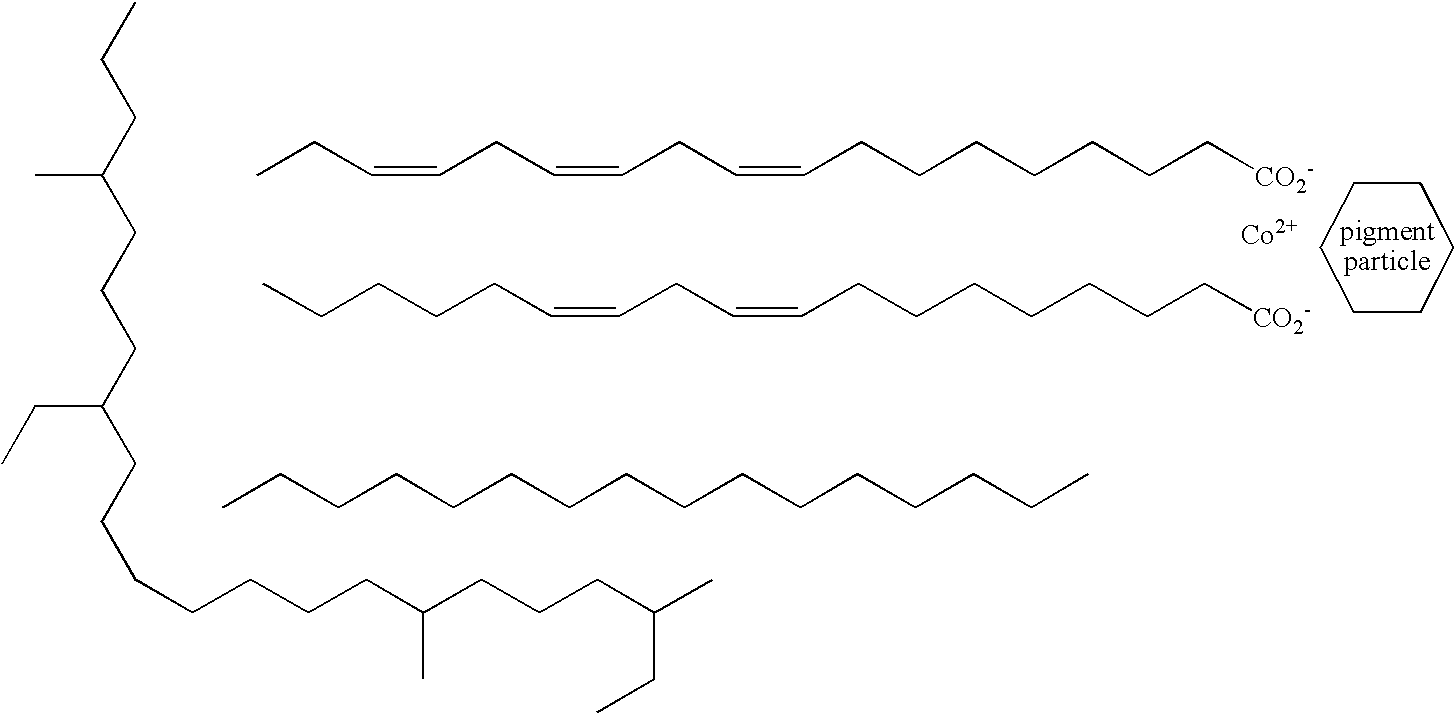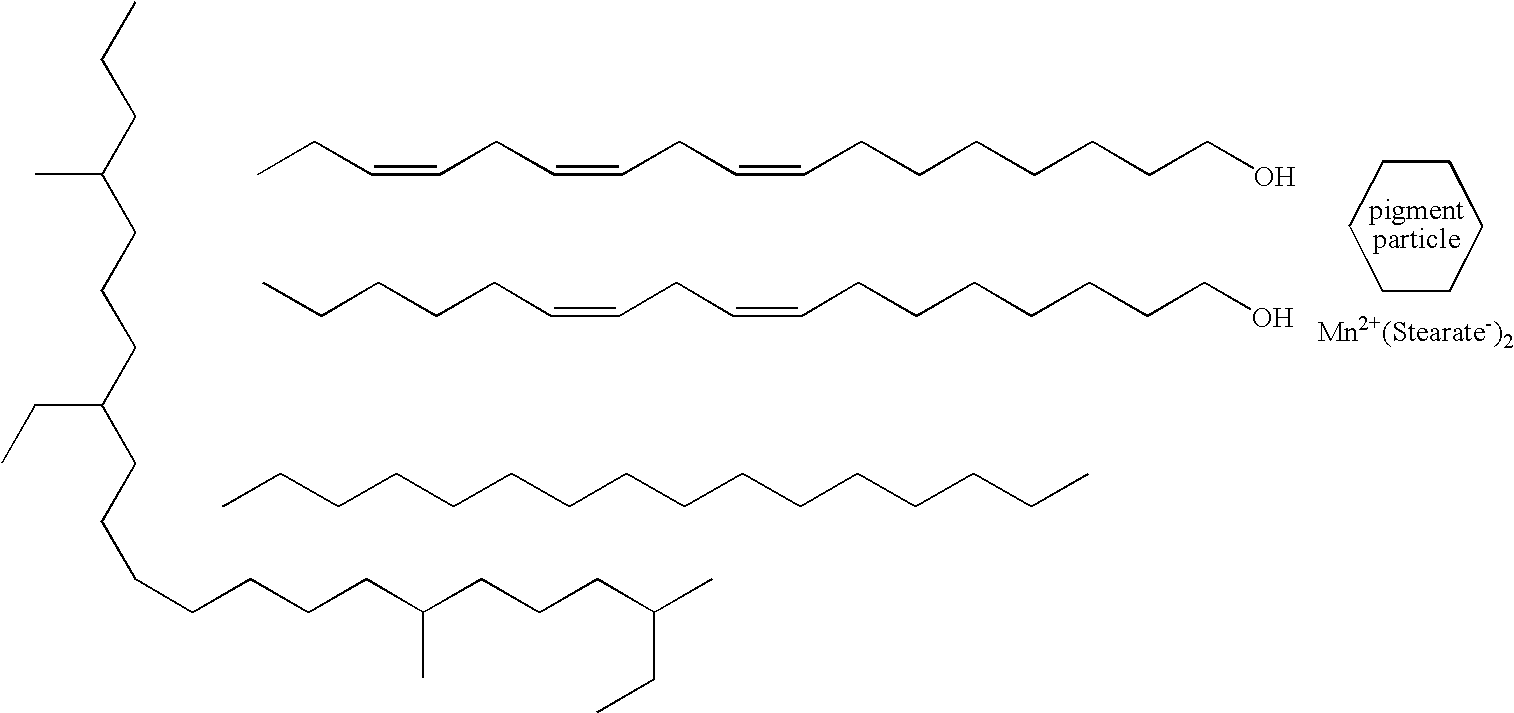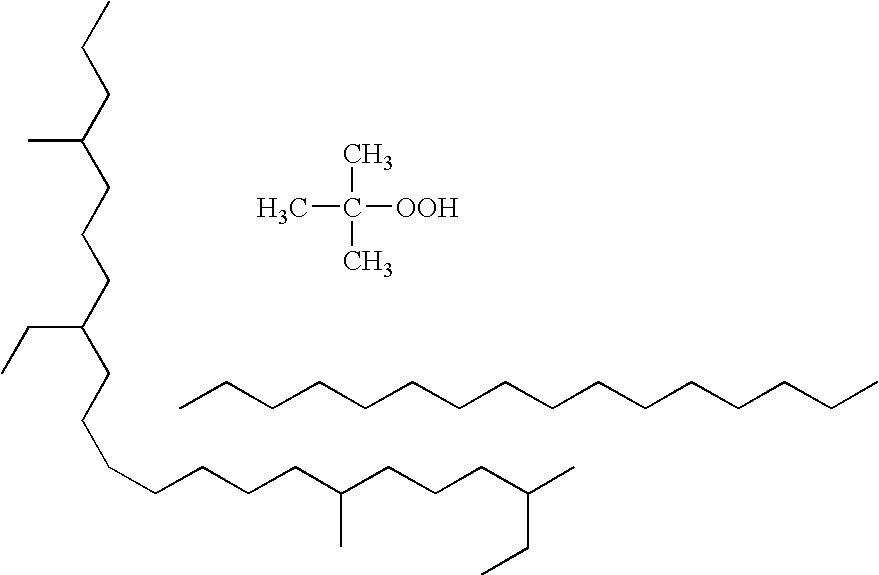Overcoat compositions, oil-based ink compositions, and processes for ink-jet recording using overcoat and oil-based ink compositions
a technology of compositions and compositions, applied in the field of inkjet recording, can solve the problems of poor image quality of images produced on plain paper using oil-based ink compositions, image edges ragged, and image quality of images on plain paper can also be inferior
- Summary
- Abstract
- Description
- Claims
- Application Information
AI Technical Summary
Benefits of technology
Problems solved by technology
Method used
Image
Examples
example 1
Latex Preparation
[0104] A poly(vinyl acetate) latex stabilized with poly(isobutylene-g-vinyl acetate) amphipathic copolymer is obtained as follows:
[0105] Polyisobutylene, 30 grams, is dissolved in 500 ml of n-hexadecane (47.0% by weight; available from Exxon Mobil Corporation and Sigma Aldrich). The solution is heated to 75° C. and purged with nitrogen for 30 minutes. To this solution, 5 ml of vinyl acetate and 0.75 grams of benzoyl peroxide are added. Polymerization is allowed to proceed for about 16 hours under constant stirring at 75° C. to obtain the amphipathic copolymer poly(isobutylene-g-vinyl acetate).
[0106] The prepared 500 ml solution of poly(isobutylene-g-vinyl acetate) is heated to 80° C. while being purged with nitrogen for 30 minutes. To this solution, 1.5 grams of benzoyl peroxide is added, followed by 110 ml of vinyl acetate. After about 30 minutes at 80° C., the solution becomes opalescent. The reaction is allowed to proceed for another 16 hours under constant st...
example 2
Latex Preparation
[0107] A poly(vinyl acetate) latex stabilized with poly(isobutylene-g-vinyl acetate) amphipathic copolymer is obtained as follows:
[0108] Polyisobutylene,30 grams, is dissolved in 500 ml of a vehicle that is 61.1% by vehicle weight of NORPAR 15 and 38.9% by vehicle weight of ISOPAR V (both available from Exxon Mobil Corporation). The solution is heated to 75° C. and purged with nitrogen for 30 minutes. To this solution, 5 ml of vinyl acetate and 0.75 grams of benzoyl peroxide are added. Polymerization is allowed to proceed for about 16 hours under constant stirring at 75° C. to obtain the amphipathic copolymer poly(isobutylene-g-vinyl acetate).
[0109] The prepared 500 ml solution of poly(isobutylene-g-vinyl acetate) is heated to 80° C. while being purged with nitrogen for 30 minutes. To this solution, 1.5 grams of benzoyl peroxide is added, followed by 110 ml of vinyl acetate. After about 30 minutes at 80° C., the solution becomes opalescent. The reaction is allowe...
example 3
Latex Preparation
[0110] A poly(vinyl acetate) latex stabilized with poly(isobutylene-g-vinyl acetate) amphipathic copolymer is obtained as follows:
[0111] Polyisobutylene, 30 grams, is dissolved in 500 ml of a vehicle that is 36.9% by vehicle weight of NORPAR 15 and 63.1% by vehicle weight of ISOPAR V (both available from Exxon Mobil Corporation). The solution is heated to 75° C. and purged with nitrogen for 30 minutes. To this solution, 5 ml of vinyl acetate and 0.75 grams of benzoyl peroxide are added. Polymerization is allowed to proceed for about 16 hours under constant stirring at 75° C. to obtain the amphipathic copolymer poly(isobutylene-g-vinyl acetate).
[0112] The prepared 500 ml solution of poly(isobutylene-g-vinyl acetate) is heated to 80° C. while being purged with nitrogen for 30 minutes. To this solution, 1.5 grams of benzoyl peroxide is added, followed by 110 ml of vinyl acetate. After about 30 minutes at 80° C., the solution becomes opalescent. The reaction is allow...
PUM
 Login to View More
Login to View More Abstract
Description
Claims
Application Information
 Login to View More
Login to View More - R&D
- Intellectual Property
- Life Sciences
- Materials
- Tech Scout
- Unparalleled Data Quality
- Higher Quality Content
- 60% Fewer Hallucinations
Browse by: Latest US Patents, China's latest patents, Technical Efficacy Thesaurus, Application Domain, Technology Topic, Popular Technical Reports.
© 2025 PatSnap. All rights reserved.Legal|Privacy policy|Modern Slavery Act Transparency Statement|Sitemap|About US| Contact US: help@patsnap.com



